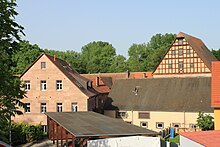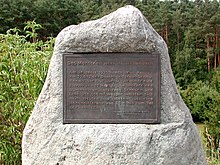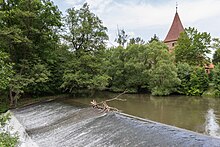Katzwang
|
Katzwang
City of Nuremberg
|
|
|---|---|
| Coordinates: 49 ° 21 ′ 0 ″ N , 11 ° 3 ′ 27 ″ E | |
| Height : | 319 (310-335) m |
| Area : | 4.78 km² |
| Residents : | 7217 (Dec. 31, 2003) |
| Population density : | 1,510 inhabitants / km² |
| Incorporation : | July 1, 1972 |
| Postcodes : | 90455, 90453 |
| Primaries : | 0911, 09122 |
|
Location of Katzwang in Nuremberg
|
|
|
Evangelical Parish Church "Our Lady"
|
|
Katzwang is a southern district of the central Franconian city of Nuremberg .


geography
location
The district extends in the extreme south of the urban area in statistical district 48 between the Rednitz , which flows from south to north, and the Main-Danube Canal, which also runs south-north . The Nuremberg city limits run to the west and south of Katzwang.
Neighboring places
To the north of Katzwang is the Nuremberg district of Reichelsdorf , to the east of the Main-Danube Canal are the Rote Bühl , Gaulnhofen , Weiherhaus and Greuth and Kornburg , to which there is a direct road connection through three bridges over the Main-Danube Canal. In the south or southeast lies Neuses , a district of Wendelstein in the district of Roth , in the west the area of the city of Schwabach with the districts of Limbach and Wolkersdorf .
City structure
The district consists of the three city districts 483 Neukatzwang in the north and the southern 484 Katzwang (Neuseser Straße) and 485 Katzwang (Wolkersdorfer Straße) in the west.
history
Katzwang was first mentioned in a document in 1152. In 1287, Bishop Emicho von Freising , Wildgrave von Wittelsbach granted an indulgence for the construction of churches and bridges. The Rednitz crossing between Nuremberg and Schwabach was of strategic importance. Local Cistercian monks were able to have a stone church built by paying church fines. Further indulgence letters followed, including in May 1301, when Bishop Konrad von Eichstätt drew a third. The bridge on the former Rednitzfurt, worth mentioning in this context, connected Nuremberg with Weissenburg . Another important trade route led from Ansbach via Schwabach to Altdorf , possibly over the same bridge. However, the latter is not historically certain. In 1296, Katzwang , which had previously belonged to the Ellwangen Monastery, was sold to the Ebrach Monastery . The place was repeatedly ravaged by epidemics; In 1562, 217 people died of plague, dysentery and cholera. There were further epidemic waves in 1575 with 128 deaths and in 1606 with 168 deaths. During the Thirty Years' War , the church register recorded 60 troop movements from which the village suffered. Katzwang went to the Kingdom of Prussia in 1792 and became part of the Kingdom of Bavaria in 1806 . Together with the hamlet of Greuth, which is now part of Kornburg , Katzwang became a tax district, and in 1818 a municipality . The districts of Neukatzwang and Reichelsdorfer Keller emerged in the 20th century . The latter now forms a separate district of Nuremberg (District 482). In the course of the municipal reform on July 1, 1972, it was incorporated into Nuremberg . During construction work on the Main-Danube Canal, the dam broke on March 26, 1979 . About 800 million liters of water poured out of the section of the canal, which was still under construction but was already flooded, and flooded large parts of the old town center. 120 houses were damaged, a 12-year-old girl was killed. The property damage amounted to 12 million Deutschmarks .
Population development
- 1818: 447 inhabitants
- 1875: 631 inhabitants
- 1950: 1893 inhabitants
- 2003: 7217 inhabitants
religion
The Katzwang officially converted to the teaching of Martin Luther in 1527 . Since then, the old church “Our Lady” has been Evangelical-Lutheran . Nevertheless, Katzwang belonged to the Cistercian monastery in Ebrach in the Steigerwald until 1803 . Only through the secularization did Ebrach lose the right of patronage. Today's Protestant parish in Katzwang has around 4,000 members. In 1875 there were again 28 Catholics in the village. This brought about the establishment of a curate that was administered by the Schwabach parish. By 1936 the Catholic community grew to 283 members, which is why a small wooden church was built. After the Second World War , many Catholic expellees came to Katzwang. As a result, the number of Catholics rose to 2,200 by 1956, which is why a parish was set up in Katzwang again that year . In 1969 the congregation inaugurated today's church “ Assumption of Mary ” on Stadtweg. At the beginning of the 21st century, the community had around 3,200 members.
politics
Local spokesman and administration
After none of the Katzwang candidates could move into the city council in the local elections in 2008, the Katzwang citizens of the municipal code elected a local spokesman who is supposed to represent the interests of Katzwang as an incorporated district in the city council. The chairman of the Katzwang Citizens' Association, Hans Mitterreiter, was elected with 53.4% of the votes cast. His opponent, Werner Reindl from the CSU, received 46.3%. In the old town hall in Katzwang on Hans-Traut-Straße is the Bürgeramt Süd, one of the three civil offices established in Nuremberg after the regional reform. These branch offices of the city administration offer the citizens of the surrounding districts all the services of a normal city hall, such as vehicle registration, residents' registration and the registry office.
Municipal coat of arms
The municipality tried to get a coat of arms as early as 1939, but these efforts came to a standstill when the Second World War broke out. In 1951, the municipal council submitted an application to the Bavarian State Ministry of the Interior for the award of the coat of arms, which was also approved a few weeks after the application was submitted. The crosier in the coat of arms goes back to Ebrach Monastery, which must have had a strong influence on the region. The origin of the cat in the coat of arms can no longer be clearly clarified. The name of the municipality is represented in today's coat of arms: the cat for "katz-" and a green, wet meadow for "-wang" ("-wang" means something like "meadow on a slope").
Culture and sights
Buildings
The village character of Katzwang has largely disappeared behind the typical suburban development. Medieval buildings are only visible around the old parish church “Our Lady”. In addition to the fortified church of Katzwang , which was first mentioned in 1287 , there is still a charnel house from the 14th century. There are also two hipped roof buildings with the old rectory from the 17th century and the schoolhouse from 1888 . An old hammer mill is also preserved . In the Protestant parish church there is, among other things, the approximately 500 year old St. Mary's altar, created by Hans Traut von Speyer, who was naturalized in Nuremberg. Further works of art in the church were created around 1500: wall frescoes, the Leonhard altar, the resurrection tables, the sacrament house and what is probably the most valuable work of art, the life-size crucifix by Veit Wirsberger.
Sports
On May 21, 1905, workers founded the Katzwang Workers' Gymnastics Club, which is now known as the Katzwang 1905 e. V. operates. In 1909 a football department was founded, the first men's team to record the greatest successes being the Central Franconian cup victory in 1937 and from 1992 to 1995 belonging to the fifth highest division, the national league . The ultra runner Hans Reich is known from the athletics department . He held the world record in the 200 km run for a long time. In 2005 he was still the world record holder in the age group of 55 in the 100 km run and over 50 miles. He achieved both best times in 1992. The best known representative of the association is, however, since the 2004 Olympic Games in Athens , the swimmer Daniela Gotz after there with the squadron had won about 4 x 100m medley bronze. After this success she switched to SSG 81 Erlangen because of the better prospects .
education
A schoolmaster was employed for the first time as early as 1650. In 1712 the construction of a school house is mentioned. New buildings take place in 1888 and from 1951. In 2003, 333 pupils were taught at the primary and secondary school in Nuremberg-Katzwang (grades 1 to 9).
Personalities
- Ferdinand Wenauer , former player of 1. FC Nürnberg (in the club since 1954; Bundesliga player 1963-1969) and German champion in 1961 and 1968, lived in Katzwang and was the coach of the first team at TSV Katzwang.
- Next to him, players of 1. FC Nürnberg have lived in Katzwang again and again, for example Reinhard Adelmann (Bundesliga player 1966–1967), Wolfgang Frank (in the club 1980–1982), David Jarolim (in the club 2000–2003) or Christian Eigler ( in the club 1993–2000 (youth) and 2008–2012).
- Michael Wolfinger , specialist author and pioneer of aquaristics , especially in the field of freshwater shrimp and Malawi cichlids
literature
- Helmut Beer: Turn- und Sportverein Katzwang 1905 eV In: Michael Diefenbacher , Rudolf Endres (Hrsg.): Stadtlexikon Nürnberg . 2nd, improved edition. W. Tümmels Verlag, Nuremberg 2000, ISBN 3-921590-69-8 , p. 1097 ( online ).
- Nikolaus Bencker: Katzwang . In: Michael Diefenbacher , Rudolf Endres (Hrsg.): Stadtlexikon Nürnberg . 2nd, improved edition. W. Tümmels Verlag, Nuremberg 2000, ISBN 3-921590-69-8 , p. 527 f . ( online ).
- Johann Kaspar Bundschuh : Katzwang . In: Geographical Statistical-Topographical Lexicon of Franconia . tape 3 : I-Ne . Verlag der Stettinische Buchhandlung, Ulm 1801, DNB 790364301 , OCLC 833753092 , Sp. 69 ( digitized version ).
- Friedrich Eigler : Schwabach (= Historical Atlas of Bavaria, part of Franconia . I, 28). Michael Laßleben, Kallmünz 1990, ISBN 3-7696-9941-6 , p. 399, 493 .
- Günther P. Fehring , Anton Ress , Wilhelm Schwemmer: The city of Nuremberg (= Bavarian art monuments . Volume 10 ). 2nd Edition. Deutscher Kunstverlag, Munich 1977, ISBN 3-422-00550-1 , p. 356-361 .
- Karl Gröber, Felix Mader : City and district of Schwabach (= The art monuments of Bavaria . Middle Franconia 7). R. Oldenburg, Munich 1939, DNB 366496239 , p. 193-238 .
- Gottfried Stieber: Katzwang . In: Historical and topographical news from the Principality of Brandenburg-Onolzbach . Johann Jacob Enderes, Schwabach 1761, p. 520-521 ( digitized version ).
- Georg Stolz: Our Lady (Katzwang) . In: Michael Diefenbacher , Rudolf Endres (Hrsg.): Stadtlexikon Nürnberg . 2nd, improved edition. W. Tümmels Verlag, Nuremberg 2000, ISBN 3-921590-69-8 , p. 1121 ( online ).
- Pleikard Joseph Stumpf : Katzwang . In: Bavaria: a geographical-statistical-historical handbook of the kingdom; for the Bavarian people . Second part. Munich 1853, p. 762 ( digitized version ).
- Willi Ulsamer (Ed.): 100 Years of the Schwabach District (1862–1962). A home book . Schwabach 1964, DNB 984880232 , p. 331-350 .
Web links
- Katzwang in the location database of the Bavarian State Library Online . Bayerische Staatsbibliothek, accessed on September 26, 2019.
- Katzwang in the Topographia Franconiae of the University of Würzburg , accessed on September 26, 2019.
- Katzwang in the historical directory of the Verein für Computergenealogie , accessed on September 26, 2019
Individual evidence
- ^ Wilhelm Volkert (ed.): Handbook of Bavarian offices, communities and courts 1799–1980 . CH Beck, Munich 1983, ISBN 3-406-09669-7 , p. 602 .
- ^ City of Nuremberg, Office for Urban Research and Statistics for Nuremberg and Fürth (ed.): Statistical Yearbook of the City of Nuremberg 2016 . December 2015, ISSN 0944-1514 , 18 Statistical City Districts and Districts, p. 19-20 , p. 20 ( nuernberg.de [PDF; 6.3 MB ; accessed on November 1, 2017]).
- ↑ nordbayern.de from March 26, 2019: 40 years ago today: A deadly water roller rolled over Katzwang





